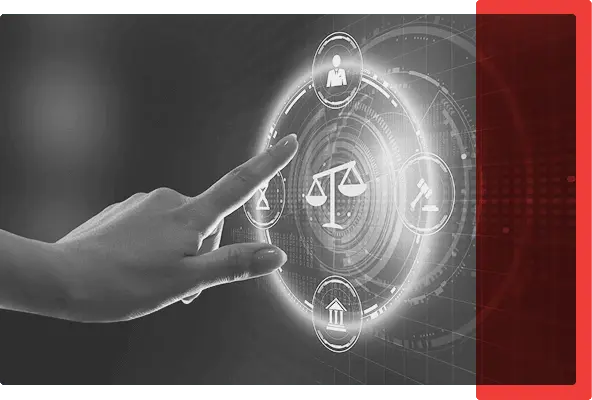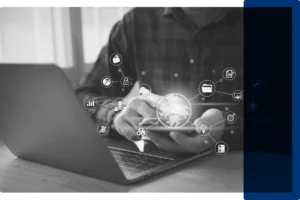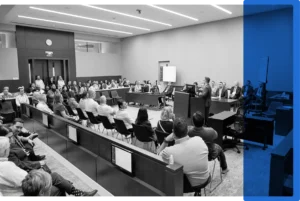
15 Apr
2025
AI Has Been in Courtrooms for Years—You Just Didn’t Call It That
When people hear the term “AI” today, it often conjures images of robots replacing jobs, science-fiction-like decision making, or complex generative tools creating deepfakes. But the truth is far more familiar—and less frightening.
Artificial intelligence, in its most basic form, has been quietly supporting business, government, and court operations for decades. In fact, courts have been relying on AI-driven tools long before the term became associated with alarmist headlines. That’s not to say there aren’t valid concerns: the rise of generative AI, synthetic media, and increasingly sophisticated algorithms is raising important questions on authenticity, fairness, and security. However, it’s important to approach these conversations with clarity, not fear.
A Brief History: AI in Everyday Business Since the 1970s
AI isn’t new: it didn’t arrive with ChatGPT or even with Siri. Some of the earliest practical uses of AI date back to the 1970s, when banks and large corporations began using expert systems to automate decisions based on predefined rules.
Examples include:
- Credit scoring algorithms that assessed loan eligibility
- Inventory management systems that predicted restocking needs
- Fraud detection tools that flagged unusual transactions
These systems weren’t making creative decisions—they were using large sets of data and consistent logic to perform tasks faster and more reliably than a human could.
By the 1990s, AI-powered voice recognition tools were entering call centers and dictation software. In the early 2000s, email spam filters and search engine ranking algorithms became common—both powered by AI models trained on millions of inputs.
Today, AI helps airlines optimize routes, powers fraud detection in banking, recommends courses to university students, and keeps your phone’s voice assistant running smoothly. These are all examples of narrow AI—designed to perform one task very well, with no risk of going beyond its purpose.
Courts Have Quietly Used AI for Years, Too
The justice system isn’t new to AI, either. Long before generative models or predictive algorithms, courts began adopting digital tools that leveraged AI to improve accuracy and efficiency—often without realizing the technology behind them could be classified as AI.
For example:
- E-discovery platforms scan, sort, and prioritize thousands of documents based on relevance
- Legal research tools such as Westlaw Edge or Lexis+ suggest related case law, statutes, or precedents using machine learning
- Court scheduling systems use AI to predict conflicts and optimize calendars
- Contract analysis software highlights risks or flags missing clauses based on trained legal models
- Risk assessment tools evaluate the likelihood of re-offense or failure to appear (e.g., COMPAS)
In each of these examples, AI isn’t replacing legal reasoning—it’s amplifying it. It’s helping lawyers and court personnel work faster, with greater clarity, and with more confidence in the materials they review.
At For The Record, we’ve long used structured, purpose-built AI in our speech-to-text tools and audio processing algorithms—focused on improving clarity, accuracy, and accessibility of the official record. FTR RealTime, our speech-to-text solution, turns the spoken word into draft transcripts using AI models that recognize and process legal terminology, varying accents, multi-speaker conversations, and overtalk. While the text it produces is a draft, it provides an immediate, readable reference that makes the audio more accessible to all participants. It’s still up to the court, attorneys, or clerks to review and verify against the ‘source of truth’: the official audio recordings.
Ultimately, the features of FTR RealTime improve clarity, boost efficiency, and ensure seamless proceedings for court staff and participants alike.
Examples include:
- Speaker separation (diarization) in courtroom audio, helping to identify who is speaking at a given time
- Automated time stamping in recordings, making it easier to locate specific testimony
- Audio enhancement algorithms that improve clarity in noisy environments
- Keyword and phrase search functionality in audio and transcripts to support faster document review
All of these features of FTR RealTime leverage foundational elements of AI—such as pattern recognition and signal processing—along with natural language processing (NLP), a specialized field within AI that focuses on enabling machines to understand, interpret, and organize human language. As AI continues to evolve, we’re focused on expanding its role in appropriate ways that support transparency, efficiency, security, and human oversight.
From Familiar Tools to Everyday Practice
As the role of AI in legal technology continues to expand, it’s important to remember that its purpose remains the same: to support—not supplant—the work of legal professionals.
At For The Record, we’re committed to keeping human expertise at the center while using the best tools available to enhance access to justice. AI may feel like a new frontier—but in reality, it’s been here for a long time. Just as there has been an evolution of tools, capabilities, and expectations, there will also be an evolution in the policies, safeguards, and human oversight that shape how AI is used.
Rather than resisting change or falling into worst-case-scenario thinking, we need to stay focused on thoughtful implementation—guided by experience, grounded in accountability, and open to adaptation. The future of AI in the courtroom will depend on the same principles that have guided its past: accountability, accuracy, and integrity.



